|
|
|
Sort Order |
|
|
|
Items / Page
|
|
|
|
|
|
|
| Srl | Item |
| 1 |
ID:
151823


|
|
|
|
|
| Summary/Abstract |
The privatization process that engulfed most Israeli kibbutzim influenced cultural changes in the Newplast factory. Following organizational difficulties and economic losses, the kibbutz management appointed a factory manager from outside to oversee changes. This management change accelerated inevitable transformations: the collectivist culture, which had previously favoured kibbutz members, became far more capitalistic. Today, the factory operates commercially without obligations towards individuals. Nevertheless, the new management has a dual value system: supporting a capitalistic approach to the worker while fostering the factory’s ‘homelike’ image, preserving some classic collectivist values and expecting its workers to feel a familial obligation to Newplast.
|
|
|
|
|
|
|
|
|
|
|
|
|
|
|
|
| 2 |
ID:
186342
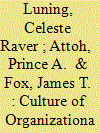

|
|
|
|
|
| Summary/Abstract |
With the backdrop of the utility of grit at the individual level, speculation has begun to circulate that grit may exist as an organizational level phenomenon. To explore this potential construct, this study used an exploratory, qualitative research design. This study explored grit at the organizational level by interviewing leaders’ perceptions of what may be a culture of organizational grit. Participants included 14 U.S. military officers. Seven themes emerged relative to the research question: “What do U.S. military officers perceive as a culture of organizational grit?” Themes included professional pride, team unity, resilience-determination, mission accomplishment, core values, growth mindset, and deliberate practice. This study indicated that a culture of organizational grit is likely a combination of converging organizational elements. Overall, findings indicate that there may be a culture of organizational grit in the military and at the least, more research examining the concept is warranted.
|
|
|
|
|
|
|
|
|
|
|
|
|
|
|
|
| 3 |
ID:
127395
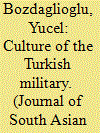

|
|
|
| 4 |
ID:
150951


|
|
|
|
|
| Publication |
New Delhi, IDSA, 2016.
|
| Description |
107p.pbk
|
| Series |
IDSA Monograph Series no; 57
|
| Standard Number |
9789382169703
|
|
|
|
|
|
|
|
|
|
|
|
Copies: C:2/I:0,R:0,Q:0
Circulation
| Accession# | Call# | Current Location | Status | Policy | Location |
| 058941 | 355.021854073/RAY 058941 | Main | On Shelf | General | |
| 058942 | 355.021854073/RAY 058942 | Main | On Shelf | General | |
|
|
|
|
| 5 |
ID:
134080
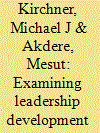

|
|
|
|
|
| Publication |
2014.
|
| Summary/Abstract |
The existing literature presents ample studies on leaders and leadership development in the United States Army. The contribution of many great military leaders of the U.S. are widely recognized both by the military community and the society at large. Reviewing the history of leadership development (LD) in the U.S. Army provides an opportunity to analyze American soldiers' development and transformation as strong leaders. Although U.S. Army training and its value systems, in many ways, have remained fundamentally the same with focus on hierarchy and structure, LD has been repeatedly refined, reframed, and redesigned based on the needs of the time and expectations of the leadership. This paper presents a review of the LD training in the U.S. Army to identify potential opportunities for the military of the Republic of Korea. It focuses on LD throughout critical periods in the history of the U.S. Army and illustrates how LD training has evolved historically. The paper also explores how Human Resource Development (HRD) as a discipline of study and its functions may be instrumental in LD by analyzing the U.S. Army's approach to LD, leadership training, organizational culture, and career development. Implications of LD for security and defense strategies are also discussed.
|
|
|
|
|
|
|
|
|
|
|
|
|
|
|
|
| 6 |
ID:
104248


|
|
|
| 7 |
ID:
074805
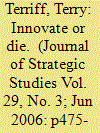

|
|
|
|
|
| Publication |
2006.
|
| Summary/Abstract |
The purpose of this article is twofold. First, this article contributes to the understanding of the origins of maneuver warfare as the capstone doctrine of the Marine Corps. It does so by identifying a second source that fostered change in the Marine Corps - one in addition to disquiet about the conduct of the war in Vietnam - which stemmed from the challenges posed by the United States' post-Vietnam strategic and military reorientation. And second, this article examines the influence of organizational culture, or identity, on innovation in the Marine Corps. A critical strand in the growing literature on military innovation focuses on organizational culture and how it influences the behavior and responses of particular military organizations. This article contributes to this literature by analyzing the influence of the organizational culture of the Marine Corps in shaping what was deemed an appropriate response to the challenges it confronted in the 1970s.
|
|
|
|
|
|
|
|
|
|
|
|
|
|
|
|
| 8 |
ID:
131888
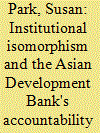

|
|
|
|
|
| Publication |
2014.
|
| Summary/Abstract |
In the 1990s Multilateral Development Banks created accountability mechanisms (AMs) that allowed people affected by development projects redress. Currently undertheorized, this paper examines how and why the Asian Development Bank (ADB) created an AM, and whether the AM serves its purpose to hold the ADB to account and to provide 'fair hearing of the views of the affected group'. This article argues that the ADB created a new AM because of institutional isomorphism, borrowing the idea of the AM from the World Bank as a result of coercive and mimetic isomorphic processes. Further, that the ADB introduced a mechanism ill-suited to the pre-existing (old) organizational culture of the ADB, which is based on consensus and hierarchical rule-following in the context of ADB operations to further economic growth while upholding state sovereignty. Despite its restructure and recent review, the mechanism's weakness was revealed through a stand-off between China and the AM over an investigation begun in 2009 (creating something 'blue'). The paper concludes that the AM's ability to serve its purpose will remain hampered as long as ADB maintains consensus around economic growth and state sovereignty over providing recourse to affected people.
|
|
|
|
|
|
|
|
|
|
|
|
|
|
|
|
| 9 |
ID:
107904


|
|
|
|
|
| Publication |
2011.
|
| Summary/Abstract |
Under what conditions can leaders achieve wartime political-military integration? In the Vietnam War, political-military integration exhibited dramatic variation: in the air war, the US was able to tightly integrate its political objectives and military conduct, but in the ground war, the American military prosecuted a strategy that was both divorced from broader political objectives and was immune from Washington's influence. I argue that the nature of information management between the military and civilian leadership explains the pattern of political-military integration in the Vietnam War more completely than do explanations that focus on the organizational cultures of professional militaries.
|
|
|
|
|
|
|
|
|
|
|
|
|
|
|
|
| 10 |
ID:
122295


|
|
|
|
|
| Publication |
2013.
|
| Summary/Abstract |
This article expands our understanding of how states respond militarily to threats and challenges by examining how organizational culture and institutional policymaking structures shape states' use of force. To evaluate the explanatory power of culture and institutions, I analyze the effect of each variable on how the United Kingdom and France conduct counterinsurgency operations. To preview the conclusions, although both organizational culture and institutional structures provide insights into how states fight insurgencies, institutional structures are much more decisive in shaping outcomes. In states where policymaking institutions promote maximal political control of the armed forces, the result will be strategic satisficing, whereby restricted force is surgically employed, along with diplomacy, to achieve the state's limited goals while minimizing the risks of casualties and/or escalation. Contrarily, in states where institutions accord operational autonomy to the armed forces, commanders will pursue their preference for decisive military victory by applying overwhelming force and conducting operations that risk escalating conflicts. In contrast to institutions, organizational culture plays a more modest role, limited to shaping how military leaders initially conceptualize the challenges they face and the techniques they employ at the tactical level. Thus, institutional structures, rather than organizational culture, offer a more convincing argument for why similar states, facing comparable challenges, use force in systematically different ways.
|
|
|
|
|
|
|
|
|
|
|
|
|
|
|
|
| 11 |
ID:
123001
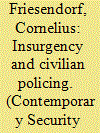

|
|
|
|
|
| Publication |
2013.
|
| Summary/Abstract |
Effective and legitimate policing is a necessary condition for the sustainable stabilization of war-torn countries. A crucial dilemma faced by international donors is whether to promote militarized or civilian policing. Particularly with insurgency and terrorism, police need robust capabilities to defend themselves and citizens against violence. At the same time, militarized police forces with weak oversight may fail to use proportionate force and serve the public. Little is known about management of this dilemma. This article argues that three established explanations - local security threats, international norms, and the political systems of donor states - do not determine the shape of police assistance programmes. Rather, the organizational cultures of donor police forces most crucially influence whether donors prioritize civilian or militarized police assistance. German support for the Afghan National Police (ANP) is a case in point. Despite deteriorating security and American pressure to support counterinsurgency, German police advisors stuck with a civilian policing model, due to their own organizational culture. Planners of foreign missions should better anticipate the organizational biases of specific donor agencies, this article concludes, to avoid frustration during the implementation phase.
|
|
|
|
|
|
|
|
|
|
|
|
|
|
|
|
| 12 |
ID:
155767
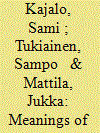

|
|
|
|
|
| Summary/Abstract |
This paper studies what kinds of meanings reserve officers ascribe to military ranks. The study builds on existing literature on reserve forces and hypothesizes that military ranks among reserve officers are subject to rendering the ranks with multiple meanings, and which are bound to create ambiguity of interpretation. To elaborate these theoretical insights a survey among Finnish reserve officers was conducted (N = 6193). The data was analyzed using factor analysis and correlation analysis. The results show that military ranks are ascribed, in addition to the functionalistic, hierarchical meaning, also with meanings of prestige, proficiency, and identity. The main theoretical contribution of the paper is in complementing the previous literature on ambiguity of military ranks by specifying four different meanings in the interpretation of the ranks.
|
|
|
|
|
|
|
|
|
|
|
|
|
|
|
|
| 13 |
ID:
138744
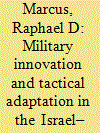

|
|
|
|
|
| Summary/Abstract |
This article highlights a pattern of military adaptation and tactical problem-solving utilized by the Israel Defense Forces (IDF) while engaged in protracted conflict with the Lebanese militant group Hizballah. It discusses the IDF’s recent attempts to institutionalize their historically intuitive process of ad-hoc learning by developing a formal tactical-level mechanism for ‘knowledge management’. The diffusion of this battlefield lesson-learning system that originated at lower-levels of the organization is examined, as well as its implementation and effectiveness during the 2006 Lebanon War. A nuanced analysis of IDF adaptation illustrates the dynamic interplay between both ‘top-down’ and ‘bottom-up’ processes of military innovation.
|
|
|
|
|
|
|
|
|
|
|
|
|
|
|
|
| 14 |
ID:
153958


|
|
|
|
|
| Summary/Abstract |
Prior studies find that military dictatorships display a high propensity to initiate militarized interstate disputes (MIDs). Yet, there is little agreement on which feature of military regimes can best explain this behavior. This article distinguishes between three potential causes: coup risk, the dictator's affiliation with the military, and the military's influence on politics. Using recent data on authoritarian regimes, I find that, whereas coup risk is a strong predictor of conflict initiation, the dictator's affiliation does not affect his foreign policy. Furthermore, I find tentative evidence that the military's influence on domestic politics has a negative effect on MID initiation. These findings thus challenge the view that military regimes' foreign policy is due to the military's organizational culture: the relationship between military regimes and dispute initiation seems to be due to factors that simply happen to add up in military autocracies but are essentially unrelated to regime type.
|
|
|
|
|
|
|
|
|
|
|
|
|
|
|
|
| 15 |
ID:
158150


|
|
|
|
|
| Summary/Abstract |
The Israel Defence Forces (IDF) face continuing challenges concerning joint operations of military services (e.g. air and ground forces) since, as in other militaries, the existence of separate service cultures creates operational difficulties. This article analyses in-depth interviews with commanders from the IDF’s air and ground forces. Its findings reinforce the ‘polarisation assumption’ of ‘us’ (the in-group) and ‘them’ (the out-group) that challenges successful cooperation, reflecting differences in the scripts of expectations and modes of action underlying perceptions of successful joint operations. These scripts create assumptions that are manifestations of a deep-rooted service culture. Such assumptions also have an effect on combat motivation as certain scenarios lead towards greater risk-taking in concrete operational situations. Cooperation between the Israeli Air Force and Special Forces is far more successful and smooth. The analysis of the success of joint operations can aid the armed forces in bridging differences and improving cooperation.
|
|
|
|
|
|
|
|
|
|
|
|
|
|
|
|
| 16 |
ID:
130369


|
|
|
| 17 |
ID:
101817
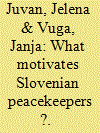

|
|
|
|
|
| Publication |
2011.
|
| Summary/Abstract |
This article is based on the results of longitudinal research on the motivations and expectations of members of the Slovenian Armed Forces participating in peace operations from 2003 to 2009. The analysis is based on three main approaches. The first is to distinguish between two groups of soldiers: those deployed to missions abroad on a voluntary basis, and those deployed to missions by order. The second approach is to distinguish between those deployed for the first time, and those who have already participated in peace support operations (PSOs) before. The third approach aims at distinguishing between three types of soldiers' motivation for PSOs according to Battistelli's typology. The importance of the different groups of motivation would to a certain degree also vary depending on the national culture, organizational culture and the individual soldier, as well as the time at which the survey was conducted: prior to deployment, during deployment or after returning home.
|
|
|
|
|
|
|
|
|
|
|
|
|
|
|
|
| 18 |
ID:
079571
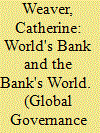

|
|
|
|
|
| Publication |
2007.
|
| Summary/Abstract |
Who or what shapes and drives the policy and operational behavior of the World Bank? The objective of this essay is to lay the conceptual and empirical framework for this special issue. I begin by constructing a synthetic theoretical model-drawing from principal-agent models and sociological institutionalism-to delineate the set of external and internal factors shaping Bank behavior. I then lay the empirical groundwork by exploring the most salient characteristics of the "world's Bank," taking special note of the Bank's relationship with the United States, borrowing states, and nongovernmental organizations. In the second half, I focus on the "Bank's world," investigating the internal bureaucratic politics and culture of the Bank. Specifically, I examine the sources and nature of the Bank's "intellectual culture" (characterized by its economistic, apolitical, and technical rationality), its "operational culture" (portrayed as driven by approval and disbursement imperatives), and the dynamics of bureaucratic politics that pervade the hierarchy of the Bank.
|
|
|
|
|
|
|
|
|
|
|
|
|
|
|
|
|
|
|
|
|